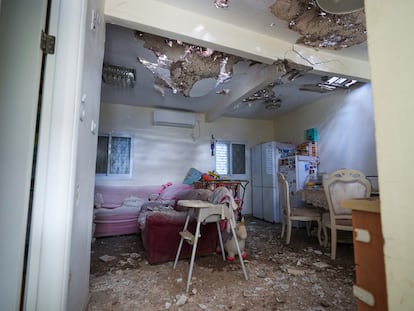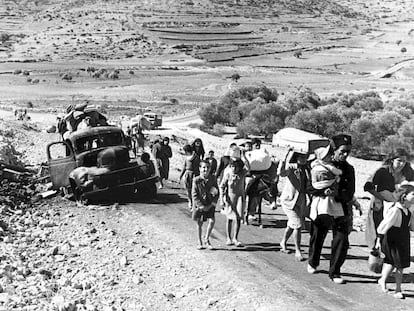Israel’s military presses Netanyahu to launch Gaza invasion
The government delays the green light for the operation, which Biden has asked to postpone, according to ‘The New York Times,’ while Israel strikes with increasing severity killing 436 people in 24 hours, according to the Gazan Ministry of Health

The Israeli army’s discomfort with Benjamin Netanyahu — made apparent in leaks to local media — for delaying the looming invasion of Gaza has reached the point of forcing them this Monday to issue an unusual joint denial. Diplomatic pressures, negotiations on hostages and on the entry of humanitarian aid, and the risk of triggering a regional war have been postponing a ground operation that was announced as imminent and militarily prepared days ago. After a series of reports on how the armed forces are losing their patience in the face of Netanyahu’s reluctance to give the definitive green light, the Israeli prime minister, his Defense Minister, Yoav Gallant, and a spokesperson for the military issued a joint statement in which they assured “to work together in close cooperation, and without rest, in pursuit of Israel’s total victory over Hamas.” Meanwhile, Israel is bombing Gaza from the air with increasing force, and Hamas announced the release of two more hostages.
“We strike all the time,” military spokesman Daniel Hagari told reporters. According to data from the Hamas government’s Health Ministry, 436 people have been killed in the past 24 hours in the heaviest airstrikes on the Strip in decades. They equal, in one day, nearly a third of all Palestinian fatalities from Operation Cast Lead (2008-2009), which lasted three weeks, and a fifth of those from Operation Defensive Shield (2014), which lasted a month and a half. The total death toll in Gaza has surpassed 5,000 on Monday, some 2,000 of them minors.
The Israel Defense Forces said the military struck over “320 military targets,” including a tunnel with Hamas militiamen. The south of the Gaza Strip has been particularly hard hit. It is the area to which the Israeli army ordered the evacuation of more than one million residents from the north. Some 700,000 have followed the instruction, according to UN estimates. The hundreds of thousands who have remained in the north “could be identified as accomplices of a terrorist organization,” the IDF has warned in messages sent to cell phones in the area and leaflets dropped from the air in the capital.
Military spokesman Hagari pointed out that the entry of humanitarian aid into southern Gaza from Egypt — which began last Saturday after days of negotiations — will allow both those already displaced and those who will be displaced “in the next phases of the war” to “stay there.” He also revealed that the second convoy of humanitarian aid (14 trucks with food, water, and medicine on Sunday) was inspected by Israeli military personnel, unlike the first. Israel and the United States have warned that they will prevent the entry of aid through the Rafah crossing — which does not include fuel and can only be delivered in the south — if any package “ends up in the hands of Hamas,” the Islamist movement that governs the Strip.
With regard to the next phase of the war, clashes between troops and militiamen inside Gaza have already intensified. In the early days after the onset of the current conflict, some Israeli soldiers crossed into Gaza, mainly to gather clues about the hostages (222, according to Monday’s updated figure). Lately, they have been carrying out “deep” raids in which they “kill cells of terrorists who are preparing for our next phase in the war,” the spokesman said. That is, militants stationed to repel the Israeli invasion. In a statement, Hamas’ armed wing, the Izz ad-Din al-Qassam Brigades, claimed victory in one of these clashes: “Our fighters engaged the infiltrating force, destroying two bulldozers and a tank, and forcing the force to withdraw. The raids and the complete destruction of buildings near the border barrier suggest that the Israeli strategy is to clear the area of both armed men and places where they can hide as snipers.”
The “next phase” has not yet begun, but the current one is expanding the conflict every day. The clashes on the Lebanese border, especially with Hezbollah, have increased in frequency and intensity to the point of displacing nearly 20,000 people in Lebanon, according to UN data. Israel has been evacuating tens of thousands of inhabitants of the area to hotels for days. The Lebanese militia has already killed 27 people, among them two cells that intended to launch anti-tank missiles and rockets.
According to The New York Times, the United States is asking for more time before the invasion is launched, which is really only the first phase of Israel’s plan to topple Hamas, which essentially consists of staying in Gaza a few months to wipe out pockets of armed resistance and get rid of its civilian administration without creating a power vacuum.
The government, and some U.S. congressmen, are trying to buy as much time as possible before Israeli soldiers cross the Gaza border. “There are so many factors at play that rushing into this is probably not the wisest thing to do,” Senator Jack Reed, a Rhode Island Democrat who heads the Armed Services Committee, told The New York Times from Cairo.
On the one hand, Washington wants to allow humanitarian aid into Gaza and try to free at least some of the hostages, after the success achieved last week with the release by Hamas of Judith and Nathalie Ranaan, an American mother and daughter. Abu Obeida, the spokesman for the military wing of the armed Islamist group, announced Monday the release “for humanitarian reasons” of two others: two elderly Israeli women, Nurit Yitzhak and Yochved Lifshitz. The International Committee of the Red Cross confirmed this in a message on X (formerly Twitter). On the other, the Biden administration aims to tie up all the loose ends of the possible ramifications of the Israeli battle plan: where each step taken by the Israeli forces may lead and what will happen in the days that follow.
Washington has already detected an increase in drone attacks against its forces, from Syria to Iraq, and fears an escalation in the activity of radical Islamic groups sponsored by Tehran in the face of the intensification of the war between Israel and Hamas, from Hezbollah in southern Lebanon against northern Israel to the Huthi rebels in Yemen or paramilitary forces in Iraq. And it is hastily reinforcing its military presence in the Middle East ahead of the Israeli ground campaign. This weekend the U.S. announced the dispatch and deployment of new anti-aircraft batteries of its Patriot and THAAD systems, the deployment of its aircraft carrier Eisenhower to the Gulf and the transfer of the amphibious group led by the ship Bataan to the eastern Mediterranean, where the aircraft carrier Gerald Ford is already stationed.
Defense Secretary Lloyd Austin warned of the possibility of a “significant escalation of attacks” against U.S. forces, citizens, or interests in the region. “If any group or country is contemplating broadening this conflict and taking advantage of this unfortunate situation […] our advice is: don’t do it,” he said Sunday on ABC’s This Week. Secretary of State Antony Blinken also acknowledged the “likelihood of an escalation” of violence by pro-Iranian groups in the region, and assured that the United States “is taking every possible measure to make sure that we can defend” U.S. and Israeli citizens.
Precisely in order to minimize the hypothesis of a direct interference by Washington, the spokesman of the White House National Security Council, John Kirby, pointed out this Monday, in a call with foreign journalists that the Israeli defense forces and their political leaders “will make the decisions about what they do, when they do it and how they do it.” But he also acknowledged that the two governments have been in constant contact since the beginning of the crisis. “Obviously, we’re curious to understand as best we can, the how, the aims, and the strategy that they’re putting into the effort. And those conversations will absolutely continue,” he stressed.
Another important factor is the opinion of Netanyahu’s military advisors. They advocate continuing and increasing air raids before entering Gaza. Netanyahu is also hesitant because of the risk that the entry of troops into Gaza will lead Hezbollah to increase its involvement, so far more limited to maintaining tension on the northern border and forcing the evacuation of border towns.
Sign up for our weekly newsletter to get more English-language news coverage from EL PAÍS USA Edition
Tu suscripción se está usando en otro dispositivo
¿Quieres añadir otro usuario a tu suscripción?
Si continúas leyendo en este dispositivo, no se podrá leer en el otro.
FlechaTu suscripción se está usando en otro dispositivo y solo puedes acceder a EL PAÍS desde un dispositivo a la vez.
Si quieres compartir tu cuenta, cambia tu suscripción a la modalidad Premium, así podrás añadir otro usuario. Cada uno accederá con su propia cuenta de email, lo que os permitirá personalizar vuestra experiencia en EL PAÍS.
¿Tienes una suscripción de empresa? Accede aquí para contratar más cuentas.
En el caso de no saber quién está usando tu cuenta, te recomendamos cambiar tu contraseña aquí.
Si decides continuar compartiendo tu cuenta, este mensaje se mostrará en tu dispositivo y en el de la otra persona que está usando tu cuenta de forma indefinida, afectando a tu experiencia de lectura. Puedes consultar aquí los términos y condiciones de la suscripción digital.
More information
Archived In
Últimas noticias
Maduro pleads not guilty before the federal court in New York: ‘I am still the president of Venezuela’
A new test can detect Alzheimer’s from a finger prick
UN team enters Sudanese city of El Fasher after paramilitary massacre: ‘It’s like a ghost town’
A recipe for resistance: Indigenous peoples politicize their struggles from the kitchen
Most viewed
- Gilles Lipovetsky: ‘If you want to live better and fall in love, take Prozac, don’t look to philosophy’
- Alain Aspect, Nobel laureate in physics: ‘Einstein was so smart that he would have had to recognize quantum entanglement’
- Alvin Hellerstein, a 92-year-old judge appointed by Bill Clinton, to preside over Maduro’s trial in New York
- Maduro’s downfall puts China’s relationship with Venezuela to the test
- Why oil has been at the center of Venezuela-US conflicts for decades










































